Abstract
Use of the Phonak DECT CP1 cordless phone improves the average speech reception threshold (SRT) by 9 dB compared to use of a standard phone. Subjective client satisfaction with the Phonak DECT phone is significantly higher than with a standard phone. These improvements can be attributed to receiving the phone signal in both ears as opposed to just one, the attenuation of the background noise and the easier positioning of the phone receiver.
Background
Hearing on the telephone is a common challenge for hearing aid wearers. In fact, different surveys report that one in five hearing aid wearers are dissatisfied when using the telephone with a hearing aid (Latzel, 2001; Kochkin 2005). The difficulty that hearing aid wearers face when using the phone is thought to be due to a number of factors: the lack of visual clues, limited frequency bandwidth of the telephone (approximately 300 to 3300 Hz), monaural listening, the presence of background noise and difficulty coupling the phone to the hearing aid.
Given that there are a variety of needs when using the telephone, Phonak offers a variety of solutions. Figure 1 shows a range of solutions for hearing on the phone, addressing a broad variety of listening needs.
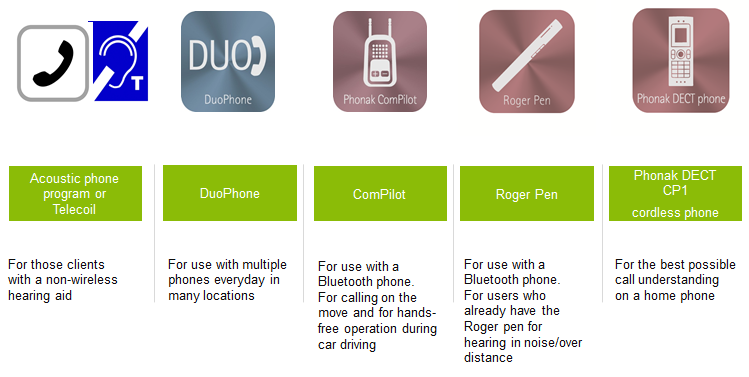
Figure 1. Phonak solutions for hearing on the phone. Different solutions are available depending on individual client needs.
The frequency response and the compression setting of the acoustic phone program in Phonak hearing aids are optimized for understanding on the phone. This acoustic phone program has the advantage that it can be used with any phone and is available in every Phonak hearing aid. The telecoil, which is available in most hearing aids, requires compatible telephones.
With the DuoPhone feature from Phonak, the phone signal is picked up by one hearing aid (via the microphone or telecoil) and is streamed using the proprietary Binaural VoiceStream TechnologyTM to the hearing aid on the other ear. While streaming, the background noise is attenuated by 6 dB (the amount of attenuation can be adjusted). DuoPhone has been shown to improve speech intelligibility on the phone (Nyfeller, 2010). The strength of the DuoPhone solution is that is can be used with any phone, both mobile and landline, as long as the feature is available in the hearing aids. DuoPhone is available in many performance levels and models of newer generation hearing aids.
A streaming device, such as the Phonak ComPilot or the new Roger Pen, deliver the phone signal from a Bluetooth-enabled cell phone to both hearing aids simultaneously. Picou and Ricketts (2011; 2013) reported that speech intelligibility was significantly improved when hearing on the telephone via wireless streaming to both hearing aids by use of a remote interface device, in comparison to hearing the phone signal monaurally.
The new addition to the Phonak phone solutions is the DECT CP1 cordless phone. It is the ideal landline phone solution for home or small offices. This state-of-the-art cordless telephone streams the phone signal to both hearing aids and can be used with any wireless Phonak hearing aids from the CORE platform (launched after 2008) onward. It does not require Bluetooth or any additional streaming devices and is fully automatic (i.e., it does not require the user to change hearing aid programs). The default 6 dB hearing aid microphone attenuation can be adjusted by the hearing care professional if required. Additionally, the volume of the phone signal can be increased via a volume boost button on the DECT phone if desired. These features help users to hear on the phone even when background noise is present. The DECT CP1 cordless phone has the advantage that apart from the streaming function, it also has an acoustic output and can be used in the standard manner by people who do not wear hearing aids. Furthermore, it offers many features one would expect from a state-of-the-art cordless phone.
Study
Objective
The objective of this study was to investigate whether use of the DECT CP1 cordless phone would result in improved speech intelligibility when compared with use of a standard phone in a situation with background noise. A second objective was to compare user satisfaction when using the DECT CP1 versus a standard phone.
Method
Fifteen subjects with moderate-severe hearing loss took part in the study. Their average audiograms can be seen in figure 2. Subjects had a hearing loss of at least 45 dB HL in the low frequencies and an air-bone gap of not more than 10 dB HL. There were 7 male and 8 female subjects whose age ranged from 57 – 83 years.
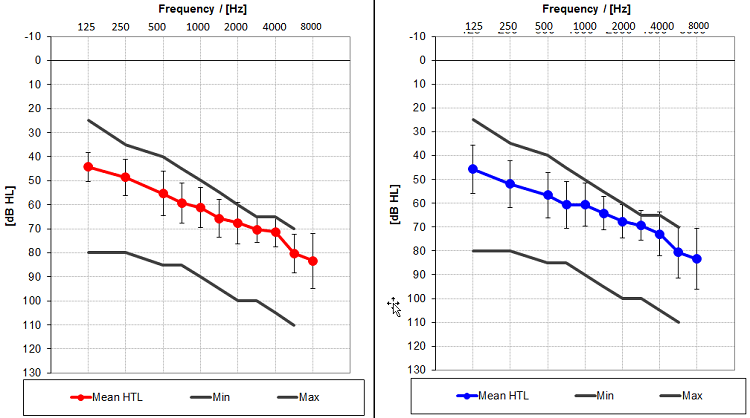
Figure 2. Average audiograms of the fifteen test subjects.
All subjects were fitted with Phonak Naida Q90-SP hearing aids. The hearing aids were programmed to first-fit using the Adaptive Phonak Digital fitting formula based on the hearing threshold, air-bone gap and uncomfortable loudness level. The hearing aids were coupled to earmolds without vents and were programmed to have an acoustic phone program where DuoPhone was disabled. This was the program used for the monaural standard phone condition. The hearing aids also had a default streaming program available for the DECT CP1 phone, which was set to default settings including a microphone attenuation of 6 dB.
The study design consisted of two parts: a speech intelligibility test and a questionnaire. For the speech intelligibility test, subjects sat at the center of a circle as can be seen in figure 3. The subjects were surrounded by four speakers at angles of 45°, 135°, 225° and 315°. The speakers each produced the International Speech Test Signal (ISTS) with slightly different delays. This overlapping of the signal produced a diffuse speech-noise environment that changed in level depending on the subjects’ answers during the speech intelligibility test, in order to obtain an SRT of 50% correct digit recognition. This setup was selected to mimic the everyday-life situation when during a conversation at home with several people, the phone rings and the hearing aid user tries to make the phone call while the other people in the room continue their conversation. The speech test material used was the Triple-Digit-Test (TDT) (Zokoll et al. (2012; 2013)) that consists of spoken combinations of three digits. This speech material was presented to the subjects via the phone receiver (either a standard acoustic phone or the DECT CP1 phone).
The standard acoustic phone used in the study was a DECT CP1 phone with the wireless streaming disabled. Without the wireless streaming, its output was equivalent to a standard phone, ensuring that the acoustical output for both phone conditions was the same.
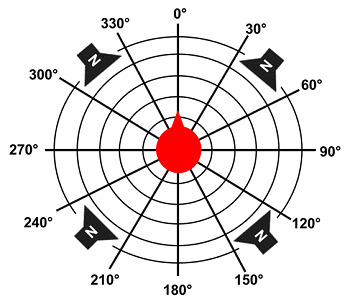
Figure 3. The test setup for the speech intelligibility test. Subjects were seated at the center of the circle surrounded by four speakers producing ISTS noise that adapted in level. Speech material was presented via the phone at a constant level of 65 dB (A).
Before commencing the speech intelligibility test, subjects initially listened to the demo recording of the phone in order to establish the most effective phone position for both phone conditions. They were then asked to type in the digit that they had heard via a touchscreen. They initially completed one training list, followed by testing with the standard phone and the DECT CP1 phone. The order in which these two phone conditions were tested was randomized. The speech material was calibrated using a Knowles Electronic Manikin for Acoustic Research (KEMAR) in order to present at a constant speech level of 65 dB (A).
Following the speech intelligibility tests, subjective user satisfaction scores were obtained. Subjects heard the TDT speech material again and filled out a questionnaire relating to their satisfaction for both phone conditions. The chosen level of presentation of noise and phone signal was dependent on the individual. The levels corresponding to the SRT for the individual subject were taken from the standard phone condition and then the noise level was increased by 3 dB. This was done in order to avoid ceiling effects for the DECT CP1 condition. The questionnaire judged listening effort, sound quality, loudness of speech and noise, effort to find the correct receiver position and overall impression for both the standard phone and for the DECT CP1 phone.
Results
The results of the speech intelligibility test are summarized in figure 4. The median SRT with use of the standard phone was 5 dB and with use of the DECT CP1 cordless phone was -4 dB. This corresponds to an improvement in SRT of 9 dB when using the DECT CP1 cordless phone. The small variance shows that almost all participants had improved speech intelligibility scores regardless of the individual hearing loss. The result is statistically significant on the 0.005 significance level (Wilcoxon Test).
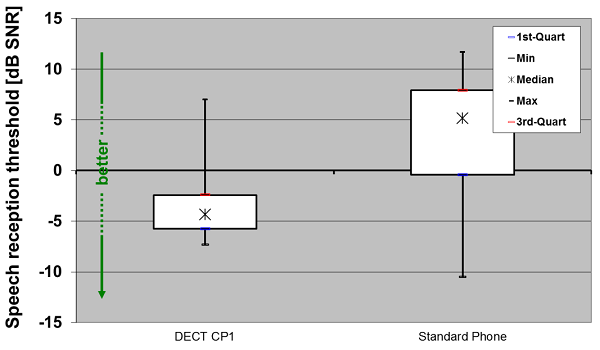
Figure 4. Speech reception thresholds for 50% correct digit recognition in adaptive noise with use of the acoustic phone and the wireless DECT CP1. The graph shows the median values of the SRT, the 1st and 3rd quartiles and the minimum and maximum values.
Figures 5 to 10 show the results of subjective judgment of different dimensions when using the DECT CP1 phone versus the standard phone. Figure 5 shows that listening with the DECT CP1 phone was rated as requiring significantly less effort compared to listening with the standard phone. Listening effort with the DECT CP1 phone was rated particularly low (median is 2.3 on a 10 point scale).
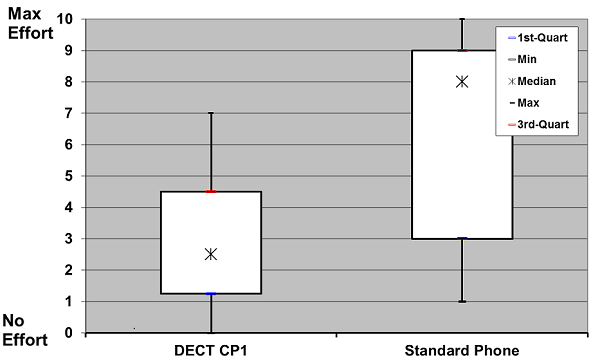
Figure 5. Subjective rating of listening effort. Subjects were asked to rate the listening effort for both the DECT CP1 phone and for the standard phone on a scale from 0-10. The graph shows the median values of the rating of listening effort, the 1st and 3rd quartiles and the minimum and maximum values.
Figure 6 shows that sound quality was rated significantly better when using the DECT CP1 phone compared to the standard phone.
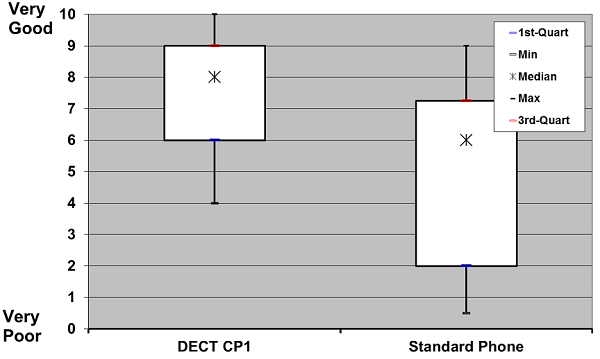
Figure 6. Subjective rating of sound quality. Subjects were asked to rate the sound quality for both the DECT CP1 phone and for the standard phone on a scale of 0-10. The graph shows the median values of the rating of the sound quality, the 1st and 3rd quartiles and the minimum and maximum values.
Figure 7 shows that the median perceived loudness of speech is “fair” for both phone conditions, but the variance of the loudness of speech for the standard phone is more in the direction of “too soft” compared to that for the DECT CP1 whose 3rd quartile and minimum lie only slightly below “fair”.
The better results for the dimensions listening effort, sound quality and loudness of speech for the DECT phone can be explained by users having no positioning problems (with the DECT phone, wireless streaming occurs as long as the phone is held within 25 cm of the hearing aids), hearing the phone signal in both ears and the attenuation of the background noise. The effective coupling of handset to receiver when using the DECT phone ensures efficient transmission of low-frequency components of speech. Other research has shown that as a consequence of effective transmission of low-frequencies, speech intelligibility and sound quality improve and listening effort drops (Picou & Ricketts, 2013; Latzel, 2001).
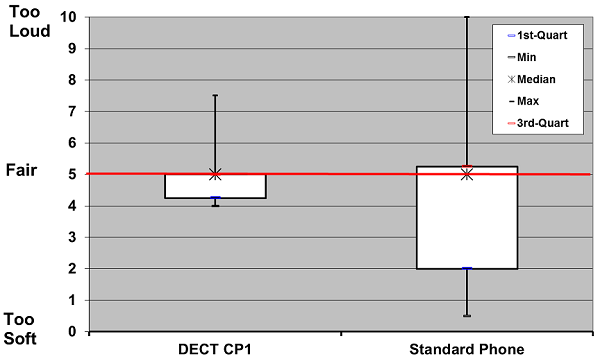
Figure 7. Subjective rating of loudness of speech. Subjects were asked to rate the loudness of speech for both the DECT CP1 phone and for the standard phone on a scale of 0-10. The graph shows the median values of the rating of the loudness of speech, the 1st and 3rd quartiles and the minimum and maximum values.
Figure 8 shows that the loudness of noise when using the standard phone was rated on average as too loud, whereas noise loudness was rated much nearer to “fair” when using the DECT CP1. This is due to the 6 dB attenuation of the hearing aid microphones when the DECT CP1 is used. Further reduction of noise can easily be achieved when using the DECT CP1 phone by increasing the microphone attenuation within the Phonak Target software.
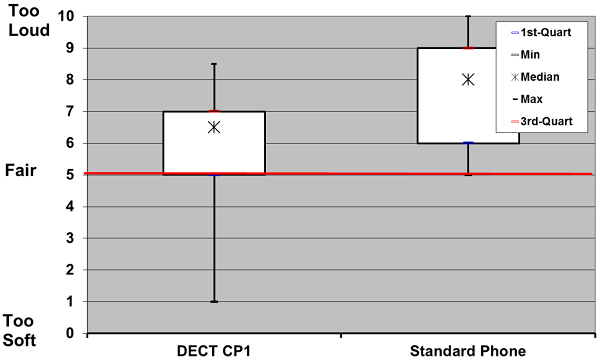
Figure 8. Subjective rating of loudness of noise. Subjects were asked to rate the loudness of noise for both the DECT CP1 phone and for the standard phone on a scale of 0-10. The graph shows the median values of the rating of the loudness of noise, the 1st and 3rd quartiles and the minimum and maximum values.
Figure 9 shows that finding the best receiver position for the optimum phone signal was rated as significantly less effort with the DECT CP1 phone than with the standard phone. Accurate positioning of a telephone receiver with hearing aids, when the hearing aid microphones are being used, is essential. This is the reason why particular precautions must be taken during research involving telephone communication in order to obtain reproducible results (Latzel, 2001). The result in figure 9 demonstrates this effect. In the case of the standard phone, the area of maximum sensitivity i.e., near the microphone, is very small and therefore more difficult to find. This accounts for the poor rating of the standard phone in figure 9. When using the DECT phone, this area of maximum sensitivity is fundamentally larger so that an optimal coupling of the speech signal is easier.
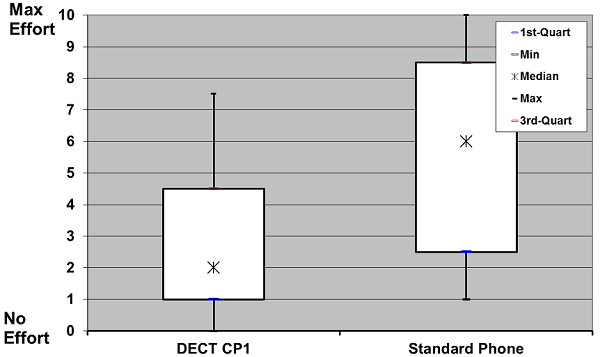
Figure 9. Subjective rating of effort to find correct listening position. Subjects were asked to rate the effort required to find a receiver position where they could hear well for both the DECT CP1 phone and for the standard phone on a scale of 0-10. The graph shows the median values of the rating of the effort to find the correct receiver position, the 1st and 3rd quartiles and the minimum and maximum values.
Figure 10 shows that subjects rated their overall impression of the DECT CP1 phone as significantly better than the standard phone. This can be attributed to very low listening effort, better sound quality and loudness of speech. A recent study showed that the DECT CP1 is also very easy to use (Stuermann, 2013).
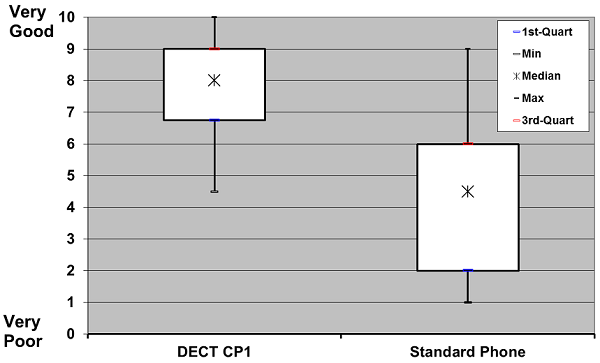
Figure 10. Subjective rating of overall impression. Subjects were asked to rate their overall impression of both the DECT CP1 phone and the standard phone on a scale of 0-10. The graph shows the median values of the overall rating, the 1st and 3rd quartiles and the minimum and maximum values.
Conclusion
Use of the Phonak DECT CP1 cordless phone resulted in a highly significant 9 dB improvement in the median SRT compared to use of a standard phone. Questionnaires revealed that subjects rated the DECT phone as significantly better than the standard phone in the domains of listening effort, sound quality, effort to find the best receiver position and overall impression.
These findings can most likely to be attributed to the fact that with the DECT CP1 phone, subjects were able to hear the phone signal in both ears. The additional attenuation of the hearing aid microphone sensitivity reduces the competing background noise and improves the signal-to-noise ratio. The streaming of the phone signal to the hearing aids means that the spatial area in which the phone signal can be efficiently received is much larger. This in turn makes positioning of the phone receiver much easier.
Kochkin (2010) has shown that overall satisfaction with hearing aids is dependent on the number of listening situations in which the hearing aids are found to be beneficial. The DECT CP1 cordless phone has been proven both objectively and subjectively to be significantly beneficial to hearing aid wearers. Conquering this difficult listening situation is an important step to increasing overall satisfaction with amplification.
References
Latzel M (2001) ‘Kommunikationsprobleme von Hörgeräteträgern bei der Telefonkommunikation: Ansätze zu deren Objektivierung und Lösung’ Doctoral thesis at the University Hospital Giessen
Kochkin, S. (2005) MarkeTrak VII: Customer satisfaction with hearing aids in the digital age. Hearing Journal 58, 30-39
Kochkin S (2010) MarkeTrak VIII: Customer satisfaction with hearing aids is slowly increasing. The Hearing Journal, Vol. 63 (1): 11-19
Nyffeler M (2010) Easier telephone conversations with both ears. Phonak Field Study News
Picou EM, Ricketts TA (2011) Comparison of Wireless and Acoustic Hearing Aid-Based Telephone Listening Strategies. Ear & Hearing 32(2):209-220
Picou E, Ricketts T (2013) Efficacy of Hearing-Aid Based Telephone Strategies for Listeners with Moderate-to-Severe Hearing Loss. Journal of the American Academy of Audiology, 24:59-70
Smits C, Kapteyn, TS, Houtgast, T (2004) Delopment and validation of an automatic speech-in-noise screening test by telephone. Int. J. Audiol.
Stuermann B (2013) Phonak DECT CP1, Binaural speech signal and easy handling. Phonak Field Study News
Zokoll MA, Wagener KC, Brand T, Buschermöhle M, Kollmeier B (2012) ‘Internationally comparable screening tests for listening in noise in several European languages: The German digit triplet test as an optimization prototype’ Int. J. Audiol. 51(9):697-707
Zokoll MA, Hochmuth S, Warzybok A, Wagener KC, Buschermöhle M, Kollmeier B (2013) ‘Speech-in-Noise Tests for Multilingual Hearing Screening and Diagnostics‘ Am. J. Audiol. 22(1):175-178
Cite this content as:
Latzel, M., and Appleton-Huber, J. (2013, October). Improvement of speech intelligibility and subjective satisfaction with the new Phonak DECT cordless phone. AudiologyOnline, Article 12223. Retrieved from: https://www.audiologyonline.com



